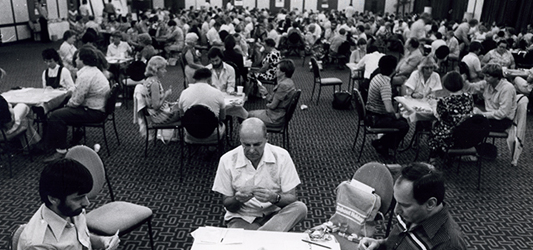
The first organised bridge associations were formed in NSW and Victoria in the early 1930’s. During that time a number of other states also formed associations. To co-ordinate the sport nationally, the states formed The Australian Bridge Council.
This organisation changed its name to the Australian Bridge Federation (ABF) in the 1960’s.
There’s nothing like being in Europe, from where I write, to bring home how isolated Australia still is. The ‘overseas’ word for a start. If you leave Australia you go overseas. Here I do my Saturday shopping in another country, and international travel, even when it is ‘overseas’ technically, rarely counts as such: the UK, for example, just a big swim if you set your mind to it.
But however isolated Australia is in contrast now, it has been so much worse in the past. Our national teams used to go on ships to get to international tournaments. Travel was excruciatingly slow and horribly expensive. All the more amazing to see how they did, winning Asian tournaments, third in more than one world championship. Even getting around Australia was a challenge compared with now – think of how popular the ANC is when it’s held in Perth because the West is still a rather exotic location we go to rarely.
Getting knocked out of the Trials early is almost a bonus – more time to see those sights. Imagine going to the first ANC in Perth in the 1960s, as unusual an experience as going overseas was, maybe even more so. The story of Australian bridge is the story of truly intrepid people overcoming the harsh geographical facts of life here.
Bridge is a baby of a game in the form we now use and Australia has been instrumental on the international scene in the development of it both from the point of view of play and organisation right from the early 1930s when the story starts. Here we have the biographies of some of the intrepid pioneers of bridge in Australia, both players and promoters. Looming largest, of course, is Tim Seres, the only Australian player who can claim to be one of the immortal greats of bridge worldwide.
But he could not have become what he was without the many others who make up the whole story. Joyce Nicholson, another who has died since the first edition of The History of Australian Bridge (the second edition is being worked on right now!) wrote a book in the 1980s in which a theme was that there is not enough room at the top of bridge. Too true. All the more important that our players are remembered here.
Cathy Chua











